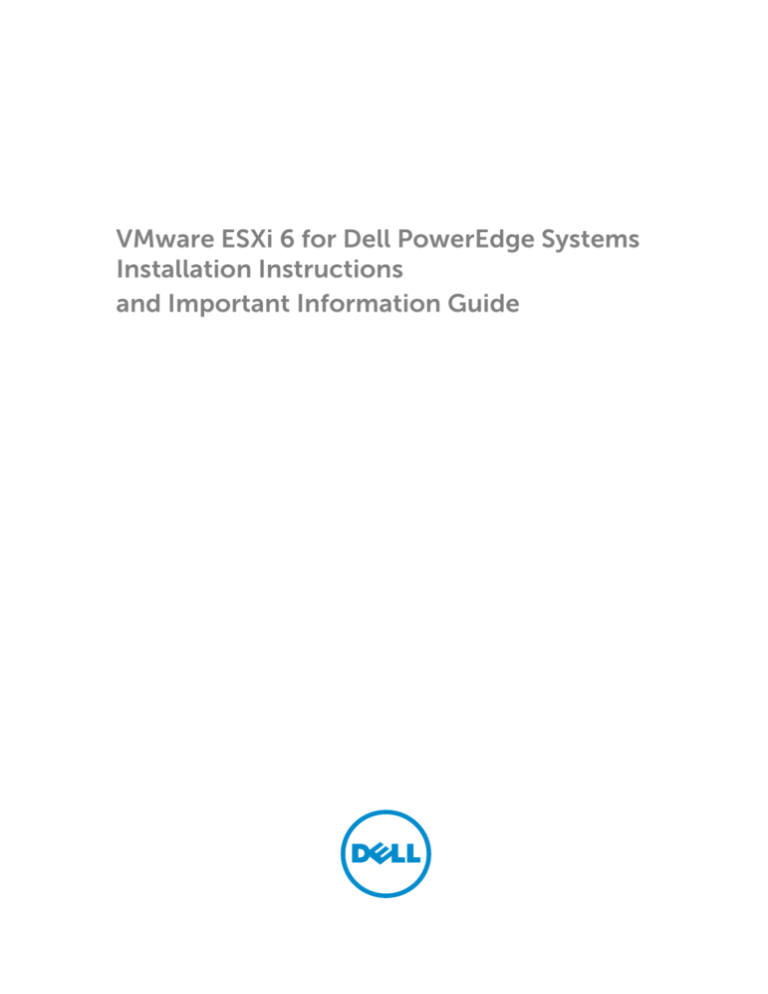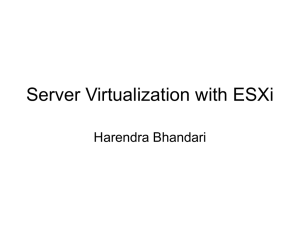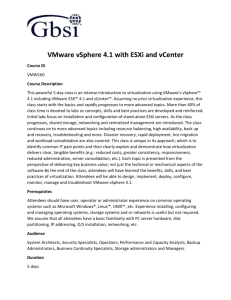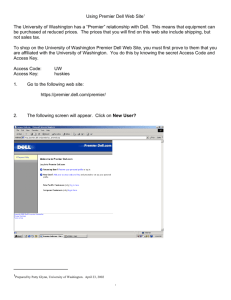
VMware ESXi 6 for Dell PowerEdge Systems
Installation Instructions
and Important Information Guide
Notes, cautions, and warnings
NOTE: A NOTE indicates important information that helps you make better use of your computer.
CAUTION: A CAUTION indicates either potential damage to hardware or loss of data and tells you
how to avoid the problem.
WARNING: A WARNING indicates a potential for property damage, personal injury, or death.
Copyright © 2015 Dell Inc. All rights reserved. This product is protected by U.S. and international copyright and
intellectual property laws. Dell™ and the Dell logo are trademarks of Dell Inc. in the United States and/or other
jurisdictions. All other marks and names mentioned herein may be trademarks of their respective companies.
2015 - 03
Rev. A00
Contents
1 Introduction........................................................................................................... 5
vSphere 6 architecture.......................................................................................................................... 5
Overview of ESXi architecture.............................................................................................................. 6
Virtual SAN installation.....................................................................................................................7
2 Installing vSphere 6.............................................................................................. 8
Downloading the ESXi installer media..................................................................................................8
Important information for the Dell-customized ESXi image.........................................................8
Installing, Enabling, and Disabling ESXi................................................................................................ 8
USB key or SD memory card installation........................................................................................9
Overview - Dell NUMA Fault Resilient Memory ............................................................................ 9
Enabling Dell NUMA Fault Resilient Memory................................................................................. 9
Overview - Dell Fault Resilient Memory....................................................................................... 10
Enabling Dell Fault Resilient Memory........................................................................................... 10
Installing ESXi on flash media........................................................................................................ 11
Installing ESXi on the hard disk drive............................................................................................ 12
Enabling or Disabling flash storage device................................................................................... 12
Configuring one-time boot to ESXi.............................................................................................. 13
Configuring boot sequence to ESXi..............................................................................................13
Downloading the patches and updates for ESXi................................................................................ 13
Creating the vCenter Server installation media..................................................................................14
Installing vCenter Server..................................................................................................................... 14
3 Deploying vSphere 6.......................................................................................... 15
Important information.........................................................................................................................15
vSphere configuration using Dell Fibre Channel SAN........................................................................16
vSphere configuration using iSCSI SAN..............................................................................................16
Booting ESXi.........................................................................................................................................17
Configuring the password................................................................................................................... 17
Configuring Lockdown mode.............................................................................................................18
Managing the management network services................................................................................... 18
4 Configuration back up and restore procedures........................................... 19
Backing up the configuration of your ESXi host................................................................................ 19
Restoring the configuration of your ESXi host.................................................................................. 20
5 Licensing information........................................................................................ 21
License evaluation............................................................................................................................... 21
3
vSphere licensing.................................................................................................................................21
Administering license keys.................................................................................................................. 21
6 Troubleshooting ESXi........................................................................................ 22
ESXi installation................................................................................................................................... 22
ESXi does not boot or displays a no OS found message at start up .......................................... 22
Purple or pink screen while booting or running your ESXi..........................................................22
Frequently Asked Questions............................................................................................................... 22
What is the minimum RAM required to install VMware ESXi on Dell PowerEdge servers?........22
Why are network adapters not detected during ESXi installation on PowerEdge servers?....... 23
Why are target devices not available in the Disk Selection wizard of ESXi installer?................. 24
Why does ESXi display the number of processors incorrectly with the Intel Xeon
processors in the Dell 13th generation BIOS settings?................................................................25
Why are keyboard inputs not received by ESXi installer?............................................................ 25
7 Getting help......................................................................................................... 26
Related information............................................................................................................................ 26
Technical support resources........................................................................................................ 26
Discussion forums.........................................................................................................................26
Knowledge base............................................................................................................................ 27
Documentation matrix........................................................................................................................ 27
Contacting Dell....................................................................................................................................27
Downloading drivers and firmware.................................................................................................... 28
4
Introduction
1
This document helps you to deploy VMware ESXi 6 on Dell systems, and provides specific information
about recommended configurations, best practices, and additional resources.
Dell offers the following VMware editions:
•
vSphere Essentials Plus
•
vSphere Standard
•
vSphere Enterprise (two and four CPU offerings only)
•
vSphere Enterprise Plus (two and four CPU offerings only)
•
VMware vCenter Server
•
VMware Virtual SAN
NOTE: vSphere Essentials Plus is an all-inclusive package that includes licenses for three physical
systems, each system with up to two processors. It also includes VMware vCenter Server to centrally
manage the systems. vSphere Essentials Plus edition is supported only on two-socket systems. More
licenses must still be deployed on approved systems for Dell support.
NOTE: With the release of vSphere 6, all Partner Activation Codes shipped with current systems are
for vSphere 6 licensing. If you have an active vSphere subscription, you can downgrade or upgrade
vSphere, as you choose. To get your downgrade keys, register your Partner Activation Code and
login to vmware.com/accounts. Go to Manage Product Licenses → vSphere v6 on the license
administration portal.
NOTE: VMware Virtual SAN is licensed independently per socket, per server. To use VMware Virtual
SAN, the server requires a vSphere license ( per socket, per server) and a vCenter Server license.
vSphere 6 architecture
vSphere infrastructure consists of the following components:
ESXi
Allows multiple operating system to run simultaneously on a single system.
vCenter server
Monitors and manages the management application of VMs and copies of ESXi.
With a vCenter server, you can create, start, stop, and migrate VMs across the
entire physical data center. vCenter server is optional, but it is required for
advanced management capabilities such as VMware vMotion, Distributed Resource
Scheduling (DRS), and High Availability (HA).
vCenter server
database
Stores all the configuration data about a VMware infrastructure environment. Dell
recommends you to use a production database such as Microsoft SQL Server or
Oracle for the vCenter Server database.
vSphere Web
Client
Shares the functionality of the core administrative interface starting from ESXi 5.1,
with the vSphere client. vSphere client can be launched from Internet Explorer or
Mozilla Firefox, without requiring a specific client installation.
5
vSphere client
Requires an ESXi host to manage, by directly connecting to it or through vCenter
Server. It can be installed on a system running a supported Windows OS. vSphere
Web Client can replace the vSphere Client for future releases. The vSphere Web
Client enables you to connect to a vCenter Server system to manage an ESXi host
or multiple hosts through a browser.
Virtual Machine
datastore
Stores VM configuration and virtual disk files. The VM storage can either be internal
local storage to the ESXi or external storage. Multiple ESXi system share VM
storage. Advanced features such as HA and DRS require that the hard disk drive and
configuration files are stored on the external shared storage.
The following figure shows the different components of vSphere.
Figure 1. vSphere components
Overview of ESXi architecture
ESXi is a bare-metal enterprise class hypervisor that can be preinstalled on Dell PowerEdge systems. With
the reduced footprint of the hypervisor, ESXi is integrated with PowerEdge systems by using embedded
Secure Digital (SD) card.
Integrated virtualization by VMware offers the following features:
•
Ease of deployment
•
Integrated hardware monitoring
•
Enhanced security
•
Reduced patch management
•
Improved reliability
The following figure shows an overview of the ESXi architecture.
6
Figure 2. ESXi architecture
Virtual SAN installation
For more information about VMware documentation for VSAN installation, see the VMware Virtual SAN
Production Information Guide at dell.com/virtualizationsolutions.
7
Installing vSphere 6
2
NOTE: If you have ordered VMware ESXi with your PowerEdge system, the PowerEdge system
comes preinstalled on the system.
Downloading the ESXi installer media
You can download the Dell-customized ESXi installer image from dell.com/support/drivers. To create
the ESXi installer media, complete the following procedure:
1.
Click Get drivers and downloads.
For more information, see Downloading drivers and firmware.
2.
Select your operating system as ESXi and download the ISO image.
Important information for the Dell-customized ESXi image
•
The Dell-customized ESXi installer ISO image content does not include Dell OpenManage Server
Administrator. For detailed instructions to install and use Dell OpenManage Server Administrator, see
the Dell OpenManage documentation at dell.com/openmanagemanuals.
•
The files that Dell creates or modifies as part of customization are:
– etc/vmware/oem.xml
– etc/vmware/support
NOTE: The list of files appended, modified, or customized by Dell may change during a later
release.
NOTE: Dell-customized ESXi image may contain additional or VMware-I/O Vendor Program
(IOVP) certified updated drivers. For more information, refer to Important Information section of
Dell customized ESXi image at dell.com/virtualizationsolutions .
•
If required, Dell may update the customized ISO for a critical patch impacting Dell to include VMware
patches or bug fixes for Dell hardware.
•
Dell OpenManage vSphere Installation Bundle (VIB) can be installed on ESXi systems, where ESXi is
installed using either the Dell Customized ESXi image or the ESXi image provided by VMware.
Installing, Enabling, and Disabling ESXi
WARNING: Only trained service technicians must perform any installation that requires removal
of the system cover. See the safety document that is shipped with your system for complete
information about safety precautions, working inside the system, and protecting against
electrostatic discharge.
NOTE: For important regulatory information, see dell.com/regulatory_compliance.
8
NOTE: If you have not ordered order ESXi with your system, you can order the Internal Dual SD
Module kit at dell.com and download the ESXi Installation media from dell.com/support. For
information about creating your ESXi media, see Downloading the ESXi installer media.
NOTE: If you have ordered the ESXi separately and your PowerEdge system is not preinstalled with
the software, complete the procedure in Installing ESXi on flash media to install ESXi.
USB key or SD memory card installation
NOTE: For more information about supported configurations of PowerEdge systems with the SD
memory card, see the VMware vSphere 6 on Dell PowerEdge and Storage Systems Compatibility
Matrix at dell.com/virtualizationsolutions.
NOTE: For instructions to install the SD memory card on the system board for supported
PowerEdge systems, see the system-specific Owner's Manual or Information Update at dell.com/
support/home.
Overview - Dell NUMA Fault Resilient Memory
NUMA FRM is a new memory operating mode available on the BIOS settings of high-end Dell’s 13th
generation of PowerEdge systems with at least two or four processors. This mode establishes an area of
memory that is fault-resilient on all CPUs, providing the same protection to the hypervisor against
uncorrectable memory errors that would affect it, as well as maintaining NUMA memory functionality and
performance.
Enabling Dell NUMA Fault Resilient Memory
The following conditions must be fulfilled before you enable NUMA FRM:
•
ESXi 6.0 must be deployed on one the following Dell PowerEdge systems:
– M630
– R730
– R730XD
– R630
– FC630
•
The BIOS version on your system must be 1.2.1 or later for 13th generation of Dell PowerEdge systems
that supports VMware ESXi 6.0.
•
The memory modules must be populated on the memory channels to support Mirror Mode. For more
information, see your system Owner’s Manual at dell.com/poweredgemanuals.
•
You need vSphere Enterprise or Enterprise Plus licensing to enable the VMware Reliable Memory
technology.
To enable FRM on your system, complete the following procedure:
1.
Turn on your system.
The Dell logo is displayed.
2.
Press F2 to open the System Setup menu.
After the system boot is completed, the System BIOS configuration menu is displayed.
3.
Using the up- and down-arrow keys, select the System Setup options, and then select the Memory
Settings screen.
9
4.
Select NUMA Fault Resilient Mode as Memory Operating Mode.
CAUTION: Dell recommends that you do not modify other settings unless you are familiar
with the settings. Modifying settings could cause your system to fail to boot or function
properly.
5.
Press Enter, and follow the on-screen procedure to save these changes.
6.
Restart your system.
NOTE: No further configuration changes are required for ESXi to use the reliable memory
region.
Overview - Dell Fault Resilient Memory
CAUTION: Do not attempt to enable Fault Resilient Memory (FRM) on vSphere versions earlier
than VMware ESXi 5.5. Up to 25 percent of system memory may be consumed to provide the FRM
zone in 12th generation of PowerEdge systems and 12.5 percent of system memory may be
consumed to provide FRM zone in 13th Generation of Dell PowerEdge Systems.
FRM is a Memory Operating mode available on the BIOS settings of high-end 12th generation Dell
PowerEdge systems and later. This mode establishes an area of memory that is fault resilient and protects
the hypervisor against uncorrectable memory errors, the system stops responding. Systems with ESXi that
supports the FRM feature can load the operating system kernel to maximize system availability and/or
critical applications or services. VMWare ESXi version 5.5 update 2 and later supports FRM through its
Reliable Memory (ReM) technology.
Enabling Dell Fault Resilient Memory
The following conditions must be fulfilled before you enable base FRM:
•
ESXi 6.0 must be deployed on one of the following Dell PowerEdge systems:
– FC630
– M630
– M620
– R920
– R820
– R730
– R730XD
– R720
– R720XD
– R630
– R620
– T630
– T620
•
The BIOS version on your system must be 1.0.4 or later for 13th generation and 2.0.19 or later for the
12th generation of Dell PowerEdge systems.
•
The memory modules must be populated on the memory channels to support Mirror Mode. For more
information, see your system Owner’s Manual at dell.com/poweredgemanuals.
•
You need vSphere Enterprise or Enterprise Plus licensing to enable the VMware Reliable Memory
technology.
To enable FRM on your system, complete the following procedure:
10
1.
Turn on your system.
The Dell logo is displayed.
2.
Press F2 to display the Setup menu.
After the system boot is completed, the System BIOS configuration menu is displayed.
3.
Using the up- and down- arrow keys, select the System Setup options, and then select the Memory
Settings screen.
4.
Select Dell Fault Resilient Mode as Memory Operating Mode.
CAUTION: Dell recommends that you do not modify other settings unless you are familiar
with the settings. Modifying settings could cause your system to fail to boot or function
properly.
5.
Press Enter, and follow the on-screen instructions to save these changes.
6.
Restart your system.
NOTE: No further configuration changes are required for ESXi to use the reliable memory
region.
Installing ESXi on flash media
After installing the SD card in your system, locate the ESXi installer media that you had created in
Downloading the ESXi installer media.
To install ESXi on the flash media, complete the following steps:
1.
Turn on the system.
NOTE: Before installing ESXi, enable the flash storage device. For more information, see
Enabling or Disabling flash storage device.
2.
Insert the ESXi installer media into the optical drive.
3.
Restart the system.
4.
When the Dell logo is displayed, press F11 immediately.
5.
At the Boot Menu, use the up- and down-arrow keys to select the optical drive and press Enter.
The installer environment starts. When the installer image loads, the system is ready to begin the
flash storage imaging process.
CAUTION: Step 6 deletes all data on SD storage device.
6.
On the Select a Disk page, select the SD storage device on which you want to install ESXi and press
Enter.
7.
Enter the root password and press F11 to start the installation.
8.
When the installation process is complete, press Enter to restart the system.
9.
When the Dell logo is displayed, press F11 immediately.
10. At the Boot Menu, use the up- and down-arrow keys to select the SD storage device, and then press
Enter.
The system boots and starts ESXi.
11. To enable recurring boot, see Configuring boot sequence to ESXi.
12. Set the correct licensing mode.
For more information, see Licensing information.
11
Installing ESXi on the hard disk drive
To install ESXi on the hard disk drive, complete the following procedure:
1.
Turn on the system.
2.
Insert the ESXi installer media that you created earlier into the optical drive.
For more information, see Downloading the ESXi installer media.
3.
When the Dell logo is displayed, press F11 immediately.
4.
At the Boot Menu, use the up- and down-arrow keys to select the optical drive and press Enter.
When the installer image loads, the system is ready to begin the installation process.
CAUTION: Step 5 deletes all data on the selected hard disk drive.
5.
On the Select a Disk page, select the hard disk drive on which you want to install ESXi and press
Enter.
6.
Enter the root password and press Enter to reboot the system.
7.
When the installation process is complete, press Enter to reboot the system.
The system restarts and starts ESXi.
8.
Set the correct licensing mode.
For more information, see Licensing information.
Enabling or Disabling flash storage device
ESXi installs on an internal flash storage device.
1.
Turn on the system.
2.
When the Dell logo is displayed, press F2 immediately to open the System Setup page.
NOTE: If you press a key on the keyboard for extended time, it may result in a keyboard failure.
To avoid possible keyboard failure, press and release F2 at even intervals until the System Setup
page is displayed.
If the OS logo is displayed instead of the System Setup page, wait until the operating system finishes
loading. Turn off the system and try again.
3.
Use the up- and down-arrow keys to select Integrated Devices, and then press Enter.
4.
To enable the Flash Storage device:
a. Select SD Card, depending upon the device is valid for your system.
b. Use the right- and left-arrow keys to enable the device.
To disable the Flash Storage device:
a. Restart ESXi and access System Setup.
b. Select SD Card, depending upon which device is valid for your system.
c. Use the right- and left-arrow keys to disable the device.
CAUTION: Booting into an operating system other than ESXi, without disabling the flash
media results in data loss.
5.
Press Enter to save your selection.
6.
Press Esc.
7.
Select Save Changes and Exit.
8.
Press Enter to exit the System Setup screen.
12
9.
Reboot the system.
10. To complete the process, perform the procedure in Configuring one-time boot to ESXi or
Configuring boot sequence to ESXi.
Configuring one-time boot to ESXi
1.
Turn on your system.
The Dell logo is displayed.
2.
Press F11 to enter the one-time boot menu option.
The menu entry changes to Entering Boot Menu, confirming your selection.
3.
The boot menu displays several boot options. Using the up- and down-arrow keys, select Hard Drive
C:.
4.
Use the right-arrow key to select SD Card.
5.
Press Enter to boot to the internal secure digital (SD) card.
Configuring boot sequence to ESXi
To boot your system to ESXi, complete the following procedure. Once the internal flash device port is
enabled, your system continues to boot to ESXi.
1.
Turn on your system.
The Dell logo is displayed.
2.
Press F2 to open the System Setup page.
After you complete the system boot, the System BIOS configuration menu is displayed.
3.
Using the up- and down-arrow keys, select Hard-Disk Boot Sequence, and then select SD Card:
Multi Card.
4.
Press the hyphen key (-) to move the SD card up in the order.
CAUTION: Dell recommends that you do not modify other settings unless you are familiar
with the settings. Modifying settings could cause your system to fail to boot or function
properly.
5.
Press Enter, and follow the on-screen procedure to save these changes.
6.
Restart your system.
Downloading the patches and updates for ESXi
NOTE: To install any patches or updates for ESXi, ensure that you follow the instructions given in
this section.
NOTE: Check for the latest patch and update releases for your ESXi version regularly and even after
you installing ESXi. For certain hardware configurations, VMware may list certain patches or updates
as required on its hardware compatibility list at vmware.com/resources/compatibility/search.php.
To check for and install the latest ESXi patch:
1.
Go to vmware.com/patchmgr/download.portal.
2.
Select ESXi (Embedded and Installable) from the Product drop-down menu.
3.
Select the version of your software from the Version drop-down menu.
4.
Click the calendar icon to enter the Release Date of the patch or select the Release Date by clicking
the calendar icon.
5.
Select All Classifications from the Classifications drop-down menu.
13
6.
Select Search.
The Download Patches page displays a list of all the patches that match the details you specified.
7.
Select the required patch and click Download Now to download the zip file.
8.
Install the patch using any of the update tools provided by VMware such as esxcli or vCenter Update
Manager.
NOTE: For more information on patch management, see vmware.com/support/pubs/.
Creating the vCenter Server installation media
1.
Go to vmware.com/download.
2.
Click the VMware vSphere 6 download link.
3.
Use your VMware store account credentials to log in to the download portal.
4.
Follow the on-screen instructions to download the vCenter Server software.
5.
Use a blank media to burn the ISO image.
You have now created your vCenter Server installation media.
Installing vCenter Server
Install and use vCenter Server to centrally manage your vSphere environment and to use all the features
of vSphere Essentials Plus, Standard, Enterprise, or Enterprise Plus edition.
1.
Insert the vCenter Server media into the optical drive.
2.
Follow the on-screen instructions.
NOTE: If the installation program does not start automatically, browse to the vCenter Server media
directory and locate autorun.exe. Double-click autorun.exe and follow the on-screen instructions.
14
Deploying vSphere 6
3
Important information
•
Dell’s 13th generation of PowerEdge system supports ESXi installation on Non-RAID Logical unit
number (LUN) or passthrough Hard disk drive (HDDs) or Solid state disk (SSDs).
•
Dell’s 13th generation of PowerEdge system supports ESXi installation on an On-board SATA
controller in Non-RAID mode.
•
For Dell’s 12th generation of PowerEdge systems having Intel Xeon E5-2600 processor series, with
ESXi 5.0 and later updates, Dell recommends that you upgrade to BIOS version 1.2.6 or later.
NOTE: BIOS version 1.2.6 contains a critical fix for the issue, which can result in a Purple Screen.
•
Dell PowerEdge systems shipped with BCM 5709 LOMs (with iSCSI offload enabled through the
hardware key) support iSCSI Boot Firmware Table (iBFT).
•
PowerEdge systems shipped with Intel Xeon 5600 series processor and later versions support Intel
Trusted Execution Technology (TXT) with the latest shipping BIOS.
•
You cannot automatically preactivate the Microsoft Windows Server 2008 and later versions operating
system installed on virtual machines by using the product activation code in the Dell OEM installation
media. Use a virtual product key to activate the guest operating system. For more information, see the
Dell OEM Windows Server 2008 Installation on Virtual Machines Using Dell OEM Media white paper at
dell.com.
•
The ESXi image preinstalled on your PowerEdge system may not contain all the drivers required for
peripherals. Additional drivers need to be installed to enable certain add-on peripherals. You can
download the drivers from downloads.vmware.com.
•
ESXi does not support storage LUN exposed from On-board SATA Controller with Software RAID.
•
vSphere 6 supports booting ESXi hosts in Unified Extensible Firmware Interface (UEFI) mode. With
UEFI, systems can be booted with ESXi from local hard drives, CD/DVD drives, or USB media. Booting
over the network requires the legacy BIOS firmware and is not available with UEFI.
•
On Non-Uniform Memory Access (NUMA) enabled systems installed with ESXi, Dell recommends that
you populate all processor nodes with similar memory to enable balanced distribution of memory
across nodes. With unbalanced memory distribution across nodes, you may face performance
degradation issues or ESXi may fail to boot.
NOTE: For more information about NUMA, see the VMware Knowledge Base articles:
kb.vmware.com/kb/1003690 and kb.vmware.com/kb/1570. Also, see VMware's Resource
Management Guide for vSphere 6 at vmware.com/support/pubs/.
•
ESXi 6.0 requires a minimum system memory of 4 GB on all supported systems. However, on some
Dell PowerEdge systems with 4 GB, all the available memory is not allocated to the ESXi installer. This
may result in an installation failure. Ensure more than 4 GB RAM is installed. For optimal memory
configuration on Dell PowerEdge servers, refer to the Server Owner’s Manual.
•
To enable the Virtualization Technology (VT) feature, select System Setup, and then Processor.
NOTE: To run 64-bit virtual machines on Intel processor-based servers, the VT feature is
required to be enabled.
15
vSphere configuration using Dell Fibre Channel SAN
If you use Fibre Channel storage, you can connect a single Fibre Channel Host Bus Adapter (HBA) to a
Fibre Channel switch that provides paths to both the storage controllers on the Fibre Channel storage
unit. To provide maximum protection against a single failure at the HBA, Fibre Channel switch, or SP level,
Dell recommends that you use two Fibre Channel HBAs on the ESXi host connected to separate Fibre
Channel switches. The Fibre Channel switches provide redundant paths to the storage controllers on the
storage unit. The following figure shows the vSphere configuration using Fibre Channel SAN.
Figure 3. Configuring vSphere using Dell Fibre Channel SAN
vSphere configuration using iSCSI SAN
The iSCSI SAN provides a cost-effective solution. Dell recommends to use two iSCSI initiators on the ESXi
host connected to two separate ethernet switches to provide redundant paths to the storage controllers
on the storage system. The following figure shows a vSphere configuration using iSCSI SAN.
16
Figure 4. Configuring vSphere with iSCSI SAN
Booting ESXi
This section describes performing the basic setup of your system based on the following assumptions:
•
You have already connected a keyboard, monitor, and mouse.
•
You have connected the first onboard NIC to your management network.
•
The network infrastructure between the two systems is working correctly prior to working with your
system and the VMware management software.
To set up your system:
1.
Turn on your system.
2.
Press F11 at boot and select the internal storage device as the one-time boot device located under
Hard Drives in the menu.
NOTE: If you ordered ESXi as the primary operating system, the boot order of the system is
already set to boot from ESXi.
NOTE: If the system fails to boot in to ESXi, set SD card as first boot device in boot sequence.
NOTE: If DHCP server is not configured in the network, valid IP address is not obtained by
default.
Configuring the password
You can use DCUI to change the password for the administrator account. The administrative user name
for the ESXi 6 host is root.
17
To change the password:
1.
Press F2 in the main ESXi Server host screen that is displayed after your system boots.
The Authentication Required screen is displayed.
2.
Select Configure Password and then press Enter.
3.
Enter the old and new passwords.
If the password is accepted, the main DCUI screen is displayed. The new password is now set.
4.
Press Esc to log out.
Configuring Lockdown mode
Lockdown mode prevents remote personnel from logging in to the ESXi host by using the root login
name. By default, lockdown mode is disabled. If you enable lockdown mode and do not configure other
local host user accounts to have standalone host access through the vSphere Client, the root user does
not have access through the vSphere API and CLI.
NOTE: When you enable the lockdown, non-VMware VIBs such as Dell OpenManage does not
work.
You can continue to access the host through the direct console or through an authorized and centralized
management application, such as vCenter Server.
1.
Select Configure Lockdown Mode and press Enter.
2.
Press Spacebar to select Enable Lockdown Mode and press Enter twice.
Managing the management network services
The ESXi 6 kernel supports IPv4, IPv6, and IEEE 802.1Q (VLAN tagging) for all management network
connections. Configuration of parameters including IP address, gateway, subnet mask, host name, and
DNS systems occurs through the DCUI.
1.
Press F2 in the main ESXi host screen that is displayed after your system boots.
The Authentication Required screen is displayed.
2.
Type your log in credentials and press Enter.
3.
Select Configure Management Network in the main DCUI customization screen, and press Enter.
The Management network configuration screen is displayed.
4.
For the PowerEdge M-series modular systems enabled with FlexAddress:
a.
b.
c.
d.
5.
18
Ensure that the variable Net.FollowHardwareMac is set to 1.
Use the vSphere Client to connect to the ESXi host.
Navigate to Configuration → Software → Advanced Settings → Net.
Set Net.FollowHardwareMac to 1 and reboot the ESXi host.
Back up your configuration settings. For more information, see Configuration back up and restore
procedures.
Configuration back up and restore
procedures
4
NOTE: Dell recommends that you back up your VMware ESXi configuration after you complete the
initial setup on a routine schedule that fits your datacenter environment. Backing up your
configuration captures the license code (host serial number).
To back up or restore the configuration information, use the VMware vSphere CLI. The vSphere CLI is
available in:
•
vSphere CLI package — vSphere CLI package can be installed on either Linux or on Microsoft
Windows operating systems.
•
vSphere Management Assistant (vMA) — vMA can be deployed on an ESXi host.
Both of these software are available for download from vmware.com. For more information on setting up
and running the vSphere CLI, see the VMware vSphere Command-Line Interface Installation and
Reference Guide and VMware ESXi Embedded and vCenter Server Setup Guide at vmware.com/support/
pubs.
The back up and restore steps are given in this section considering that:
•
You have already imported the vSphere CLI to a system other than the one you want to back up or
restore.
•
You have installed the Windows or Linux management Application Programming Interfaces (APIs).
Backing up the configuration of your ESXi host
To back up configuration data of a host:
1.
Start the vSphere CLI.
2.
Run the vicfg-cfgbackup command with the -s flag to save the host configuration to the specified
backup filename:
vicfg-cfgbackup --server< ESXi-host-ip> -- portnumber <port_number> -protocol <protocol_type> --username root --password root_password [-s
<backup-filename>
The -portnumber and -protocol options are optional. If you exclude them, the defaults are port 443
and protocol HTTPS.
NOTE: If you do not specify a password in the command line, you are prompted for one when
the command executes. For example: vicfgcfgbackup --server 172.17.13.211 -username root –s backupdate.dat
19
NOTE: If your administrative password includes special characters, such as $ or &, you must
include a backslash escape character (\) before each special character.
Restoring the configuration of your ESXi host
To restore the configuration data of a host:
NOTE: The back up process does not support restoring to later builds. This requirement can be
overridden by using the –f option.
1.
Turn off any VM that is running on the host you want to restore.
2.
Optionally, restore the host to the ESXi build number used when the backup file was created.
3.
Start the vSphere CLI on a host other than the host you want to restore and log in.
4.
Run the vicfg-cfgbackup command with the –l flag to load and restore the backup file to the host.
vicfg-cfgbackup --server <ESXi-host-IP> -- portnumber <port_number> -protocol <protocol_type>-- username <username> --password <password> -l
<backup_filename>
The -portnumber and -protocol options are optional. If you exclude them, the defaults are port 443
and protocol HTTPS.
NOTE: If you do not specify a password in the command line, you are prompted for one when
the command executes. For example: vicfgcfgbackup --server 172.17.13.211 -username root –l backupdate.dat
After a successful restore, the system reboots using the new configuration. For complete instructions
on back up and restore commands, see VMware ESXi Embedded and vCenter Server Setup Guide at
vmware.com/support/pubs.
20
Licensing information
5
This section discusses the different modes of obtaining license for your Dell PowerEdge system.
NOTE: For more information about the different editions, see vmware.com.
License evaluation
VMware allows a 60-day free evaluation period for all enterprise-level features of vSphere 6. At the end of
the evaluation period, your ESXi hypervisor may stop managing all virtual machines in the inventory. To
continue managing the virtual machines, upgrade the evaluation license to the vSphere Essentials Plus,
Standard, Enterprise, or Enterprise Plus edition license that you purchased.
vSphere licensing
If you order any vSphere license (Essentials Plus, Standard, Enterprise, Enterprise Plus, Virtual SAN, or
vCenter Server) with your server, the license certificate is shipped on a media with the server. To use the
software and receive the subscription services, register and exchange the Partner Activation Code (PAC)
printed on the license certificate for a license key or license activation code. The registration must be
completed within 30 days from the date of product purchase. With registration of the licensing or use of
the ESXi hypervisor, you are agreeing to the VMware ESXi and/or VMware vCenter Server End User
License Agreement (EULA) posted at vmware.com/download/eula/.
For information about product features and licensing methods, go to vmware.com.
Administering license keys
You can administer the license key by using vSphere Client to manage the licenses individually on the
ESXi system. Alternatively, you can use vCenter Server to manage the licenses centrally.
NOTE: For more information about administering license keys and VMware software licensing
configuration, go to vmware.com/support/pubs.
NOTE: If you receive a warning that you are disabling certain features by switching out of evaluation
mode, click OK, and then click Yes.
NOTE: Use all licensing information according to VMware’s End User Licensing Agreement.
21
Troubleshooting ESXi
6
ESXi installation
This section provides troubleshooting steps for common issues encountered during deployment of ESXi.
ESXi does not boot or displays a no OS found message at start up
Check the boot order. The correct storage device may no longer be selected as the first boot device. This
can happen if the device has recently been removed due to failure. To correct this issue, ensure that the
internal storage drive on which ESXi must be installed is assigned as the first boot device in the hard drive
sequence and the hard drive is assigned as the first boot device in the boot sequence.
Purple or pink screen while booting or running your ESXi
This is a sign of a serious misconfiguration or system error, similar to a blue screen for a Windows
operating system or kernel panic occurs for a Linux-based system. Contact Dell Support for technical
assistance.
Frequently Asked Questions
What is the minimum RAM required to install VMware ESXi on Dell
PowerEdge servers?
The minimum RAM required for installing ESXi on Dell PowerEdge servers is 8 GB.
VMware recommends a minimum of 4 GB RAM to install ESXi. However, if you install ESXi on Dell
PowerEdge systems with 4 GB RAM, the installation may fail due to insufficient memory. This is because,
a part of the RAM is occupied by the BIOS.
22
Figure 5. VMware ESXi installation failure
Why are network adapters not detected during ESXi installation on
PowerEdge servers?
Cause:
This issue occurs due to one of the following reasons:
•
The ESXi image does not contain the latest version of network drivers, for Network Daughter Cards
(NDCs) or network adapters used in Dell servers.
•
PowerEdge server does not have an NDC installed.
•
The NDC installed on the PowerEdge server is faulty
•
PowerEdge server has an NDC installed, but the NDC setting is disabled in the BIOS/UEFI.
Resolution:
1.
Use the latest available Dell customized ESXi image, which contains drivers for all NDC or network
adapters supported on Dell PowerEdge servers.
NOTE: For more information about downloading the Dell customized ESXi image, see
Downloading the ESXi installer media.
2.
Check if the NDC is working correctly.
3.
Check if the NDC setting is enabled in BIOS/UEFI.
NOTE: For more information about installing and configuring the NDC on a PowerEdge server,
see Dell PowerEdge hardware Owner’s Manual at dell.com/poweredgemanuals.
23
Figure 6. No network adapter error during ESXi installation
Why are target devices not available in the Disk Selection wizard of ESXi
installer?
Cause:
This issue occurs due to one of the following reasons:
1.
There is no PowerEdge RAID controller or Internal Dual SD Module (IDSDM) installed on the server.
2.
There are no PowerEdge RAID controllers installed in the IDSDM.
3.
The drivers for the Storage controllers are not available in the ISO image.
4.
In the BIOS configuration utility, IDSDM is disabled.
5.
In the BIOS configuration utility, the Integrated RAID controller is disabled.
6.
If the Storage controller is set to RAID mode, and virtual disks are not created with the hard drives
associated with the controller.
Resolution:
1.
Use the latest available Dell customized ESXi image, which contains drivers for all the supported
storage controllers on Dell PowerEdge servers.
2.
Ensure that the SD card is installed in the IDSDM card before installing the IDSDM card on the server.
In the BIOS configuration utility, set IDSDM to Enable.
3.
In the BIOS configuration utility, ensure that Integrated RAID Controller is set to Enable.
4.
While installing ESXi, ensure that the USB 3.0 option in the BIOS settings is set to Disable.
5.
If the Storage controller is set to RAID mode, ensure that the virtual disks are created with the hard
drives associated with the controller.
24
Figure 7. Target devices not displayed
Why does ESXi display the number of processors incorrectly with the Intel
Xeon processors in the Dell 13th generation BIOS settings?
Cause:
This issue occurs if the Snoop mode option is set to Cluster on Die in the BIOS Memory Settings screen
of a dual processor system.
Resolution:
To display the accurate number of processors, ensure that the Snoop mode option is not set to Cluster
on Die in the BIOS Memory Settings screen.
Why are keyboard inputs not received by ESXi installer?
Cause:
This issue occurs because ESXi does not have USB 3.0 drivers. When USB 3.0 option is enabled in the
BIOS settings, keyboard inputs are not received by the ESXi installer due to lack of drivers.
Resolution:
1.
While installing ESX , ensure that the USB 3.0 option in the BIOS settings is set to Disable.
2.
Ensure that you use the ESXi version, which carries USB 3.0 enablement.
25
7
Getting help
Related information
NOTE: For Dell VMware documentation, go to dell.com/virtualizationsolutions.
NOTE: For Dell OpenManage documentation, go to dell.com/openmanagemanuals.
NOTE: For all PowerEdge documentation, go to dell.com/poweredgemanuals and enter the
Service Tag of your system to get your system documentation.
Table 1. Related Documents
For information about
See
Basic configuration information for running ESXi
for a PowerEdge system.
VMware vSphere for Dell PowerEdge Systems
Getting Started Guide
Resolutions for known issues and defects
VMware vSphere for Dell PowerEdge Systems
Release Notes
vMotion support matrix for Dell PowerEdge
systems
VMware vMotion Support for Dell PowerEdge
Systems Compatibility Matrix
vSphere support matrix for Dell hardware and
software running ESXi
VMware vSphere for Dell PowerEdge Systems
Compatibility Matrix
List of components integrated in Dell Customized
ESXi Images
VMware ESXi for Dell PowerEdge Systems Image
Customization Information
Technical support resources
•
vmware.com/support
•
dell.com/support
•
dell.com/services
Discussion forums
•
vmware.com/communities/content
•
en.community.dell.com/techcenter/virtualization/w/wiki/vmware.aspx
•
dellcommunity.com
26
Knowledge base
vmware.com/support/kb
Documentation matrix
Table 2. Documentation matrix
To...
Refer to...
Install your system into a rack
Rack documentation included with your rack
solution
Set up your system and know the system technical
specifications
Getting Started With Your System that shipped with
your system or see dell.com/poweredgemanuals
Install the operating system
Operating system documentation at dell.com/
operatingsystemmanuals
Get an overview of the Dell Systems Management
offerings
Dell OpenManage Systems Management Overview
Guide at dell.com/openmanagemanuals
Configure and log in to iDRAC, set up managed
and management system, know the iDRAC
features and troubleshoot using iDRAC
Integrated Dell Remote Access Controller User's
Guide at dell.com/esmmanuals
Know about the RACADM subcommands and
supported RACADM interfaces
RACADM Command Line Reference Guide for
iDRAC and CMC at dell.com/esmmanuals
Launch, enable and disable Lifecycle Controller,
know the features, use and troubleshoot Lifecycle
Controller
Dell Lifecycle Controller User’s Guide at dell.com/
esmmanuals
Use Lifecycle Controller Remote Services
Dell Lifecycle Controller Remote Services Quick
Start Guide at dell.com/esmmanuals
Set up, use, and troubleshoot OpenManage Server
Administrator
Dell OpenManage Server Administrator User’s
Guide at dell.com/openmanagemanuals
Install, use, and troubleshoot OpenManage
Essentials
Dell OpenManage Essentials User’s Guide at
dell.com/openmanagemanuals
Know the features of the storage controller cards,
deploy the cards, and manage the storage
subsystem
Storage controller documentation at dell.com/
storagecontrollermanuals
Check the event and error messages generated by
the system firmware and agents that monitor
system components
Dell Event and Error Messages Reference Guide at
dell.com/esmmanuals
Contacting Dell
Dell provides several online and telephone-based support and service options. If you do not have an
active Internet connection, you can find contact information on your purchase invoice, packing slip, bill,
27
or Dell product catalog. Availability varies by country and product, and some services may not be
available in your area. To contact Dell for sales, technical support, or customer-service issues:
1.
Go to dell.com/support.
2.
Select your country from the drop-down menu on the bottom right corner of the page.
3.
For customized support:
a. Enter your system Service Tag in the Enter your Service Tag field.
b. Click Submit.
The support page that lists the various support categories is displayed.
4.
For general support:
a. Select your product category.
b. Select your product segment.
c. Select your product.
The support page that lists the various support categories is displayed.
Downloading drivers and firmware
It is recommended that you download and install the latest BIOS, drivers, and systems management
firmware on your system.
Ensure that you clear the web browser cache.
1.
Go to dell.com/support/drivers.
2.
In the Product Selection section, enter the Service Tag of your system in the Service Tag or Express
Service Code field.
NOTE: If you do not have the Service Tag, select Automatically detect my Service Tag for me
to allow the system to automatically detect your Service Tag, or select Choose from a list of all
Dell products to select your product from the Product Selection page.
3.
Click Get drivers and downloads.
The drivers that are applicable to your selection are displayed.
4.
28
Download the drivers you require to a USB drive, CD, or DVD.









